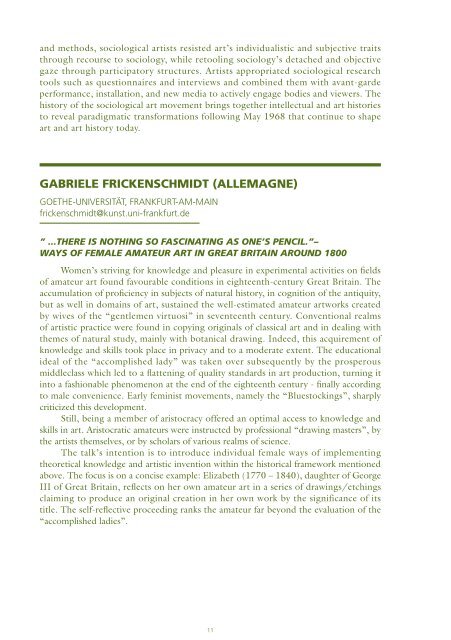COMMUNICATIONS - Réseau International pour la Formation à la ...
COMMUNICATIONS - Réseau International pour la Formation à la ...
COMMUNICATIONS - Réseau International pour la Formation à la ...
Create successful ePaper yourself
Turn your PDF publications into a flip-book with our unique Google optimized e-Paper software.
and methods, sociological artists resisted art’s individualistic and subjective traits<br />
through recourse to sociology, while retooling sociology’s detached and objective<br />
gaze through participatory structures. Artists appropriated sociological research<br />
tools such as questionnaires and interviews and combined them with avant-garde<br />
performance, instal<strong>la</strong>tion, and new media to actively engage bodies and viewers. The<br />
history of the sociological art movement brings together intellectual and art histories<br />
to reveal paradigmatic transformations following May 1968 that continue to shape<br />
art and art history today.<br />
gaBriele FriCkensChmidt (allemagne)<br />
GOETHE-UNIVERSITäT, FRANkFURT-AM-MAIN<br />
frickenschmidt@kunst.uni-frankfurt.de<br />
” ...there is nothing so fascinating as one’s penciL.”–<br />
Ways of femaLe amateur art in great britain around 1800<br />
Women’s striving for knowledge and pleasure in experimental activities on fields<br />
of amateur art found favourable conditions in eighteenth-century Great Britain. The<br />
accumu<strong>la</strong>tion of proficiency in subjects of natural history, in cognition of the antiquity,<br />
but as well in domains of art, sustained the well-estimated amateur artworks created<br />
by wives of the “gentlemen virtuosi” in seventeenth century. Conventional realms<br />
of artistic practice were found in copying originals of c<strong>la</strong>ssical art and in dealing with<br />
themes of natural study, mainly with botanical drawing. Indeed, this acquirement of<br />
knowledge and skills took p<strong>la</strong>ce in privacy and to a moderate extent. The educational<br />
ideal of the “accomplished <strong>la</strong>dy” was taken over subsequently by the prosperous<br />
middlec<strong>la</strong>ss which led to a f<strong>la</strong>ttening of quality standards in art production, turning it<br />
into a fashionable phenomenon at the end of the eighteenth century - finally according<br />
to male convenience. Early feminist movements, namely the “Bluestockings”, sharply<br />
criticized this development.<br />
Still, being a member of aristocracy offered an optimal access to knowledge and<br />
skills in art. Aristocratic amateurs were instructed by professional “drawing masters”, by<br />
the artists themselves, or by scho<strong>la</strong>rs of various realms of science.<br />
The talk’s intention is to introduce individual female ways of implementing<br />
theoretical knowledge and artistic invention within the historical framework mentioned<br />
above. The focus is on a concise example: Elizabeth (1770 – 1840), daughter of George<br />
III of Great Britain, reflects on her own amateur art in a series of drawings/etchings<br />
c<strong>la</strong>iming to produce an original creation in her own work by the significance of its<br />
title. The self-reflective proceeding ranks the amateur far beyond the evaluation of the<br />
“accomplished <strong>la</strong>dies”.<br />
11



